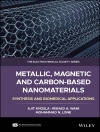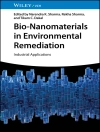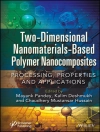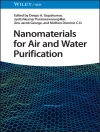Nanotechnology allows for manipulating matter at the nanoscale with unprecedented accuracy and as such holds the promise of providing new materials with distinctly different properties. In recent years, breakthroughs in nanotechnology, especially in their applications in the energy sector, have opened up the possibility of moving beyond conventional energy generation approaches by introducing technologies that are more efficient, environmentally sound and cost effective. The book brings together some of the world’s leading experts in nanotechnology and its applications in the energy sector, each covering a specific subject that falls within three general aspects: production, storage and use of energy. The first part covers the main developments of nanotechnology in clean energy production and conversion. Following a general overview on the contributions of nanomaterials for energy production, further chapters elaborate on specific topics such as photodevices,
thermoelectric materials and fuel cells. The second part is concerned with the use of nanomaterials in more efficient energy storage systems like batteries, superconductors and materials for hydrogen storage. The third and last part discusses how nanotechnology can lead to a more efficient energy usage while reducing the negative impact to the environment.
After the successful first edition of this book Nanotechnology for the Energy Challenge, the second edition has been extensively updated to include the latest progress in this field. It includes three new chapters on graphene, piezoelectric nanomaterials, and nanocatalysts for Fischer-Tropsch synthesis.
Praise for the first edition:
‘The book has a good index of technical terms, good quality graphical illustrations and a good reference list for further information. The book, which can be read either as a monograph, or by dipping into chapters of interest, should be of value to all researchers in energy and
nanotechnology.’ (Chemistry World, July 2010)
‘A ‘must’ for those with a science education and an interest in the future of our energy supply, storage and use.’ (Chemistry International, March 2010)
‘[…] this book brings under a single cover the major aspects of nanomaterials research for the energy sector and will have a profound impact on the research and development of nanomaterials for sustainable energy solutions. It is highly recommended for chemists, physicists, material scientists and engineers looking for an insight into the global energy challenge and the possible contribution nanotechnology can make.’ (Prof. Sanjay Mathur, University of Cologne)
Jadual kandungan
PREFACE TO THE 2ND EDITION
PREFACE TO THE 1ST EDITION
PART ONE: Sustainable Energy Production
NANOTECHNOLOGY FOR ENERGY PRODUCTION
Energy Challenges in the Twenty-first Century and Nanotechnology
Nanotechnology in Energy Production
New Opportunities
Outlook and Future Trends
NANOTECHNOLOGY IN DYE-SENSITIZED PHOTOELECTROCHEMICAL DEVICES
Introduction
Semiconductors and Optical Absorption
Dye Molecular Engineering
The Stable Self-Assembling Dye Monomolecular Layer
The Nanostructured Semiconductor
Recent Research Trends
Conclusions
THERMAL-ELECTRICAL ENERGY CONVERSION FROM THE NANOTECHNOLOGY PERSPECTIVE
Introduction
Established Bulk Thermoelectric Materials
Selection Criteria for Bulk Thermoelectric Materials
Survey of Size Effects
Thermoelectric Properties on the Nanoscale: Modeling and Metrology
Experimental Results and Discussions
Summary and Perspectives
PIEZOELECTRIC AND PIEZOTRONIC EFFECTS IN ENERGY HARVESTING AND CONVERSION
Introduction
Piezoelectric Effect
Piezoelectric Nanomaterials for Mechanical Energy Harvesting
Piezocatalysis – Conversion between Mechanical and Chemical Energies
Piezotronics for Enhanced Energy Conversion
Perspectives and Conclusion
GRAPHENE FOR ENERGY PRODUCTION AND STORAGE APPLICATIONS
Introduction
Graphene Supercapacitors
Graphene as a Battery/Lithium-Ion Storage
Graphene in Energy Generation Devices
Conclusions/Outlook
NANOMATERIALS FOR FUEL CELL TECHNOLOGIES
Introduction
Low-Temperature Fuel Cells
High-Temperature Fuel Cells
Conclusions
NANOCATALYSIS FOR IRON-CATALYZED FISCHER – TROPSCH SYNTHESIS: ONE PERSPECTIVE
Introduction
Nanocatalyst – Wax Separation
Summary
THE CONTRIBUTION OF NANOTECHNOLOGY TO HYDROGEN PRODUCTION
Introduction
Hydrogen Production by Semiconductor Nanomaterials
Summary
PART TWO: Efficient Energy Storage
NANOSTRUCTURED MATERIALS FOR HYDROGEN STORAGE
Introduction
Hydrogen Storage by Physisorption
Hydrogen Storage by Chemisorption
Summary
ELECTROCHEMICAL ENERGY STORAGE: THE BENEFITS OF NANOMATERIALS
Introduction
Nanomaterials for Energy Storage
Nanostructured Electrodes and Interfaces for the Electrochemical Storage of Energy
Conclusion
CARBON-BASED NANOMATERIALS FOR ELECTROCHEMICAL ENERGY STORAGE
Introduction
Nanotexture and Surface Functionality of sp2 Carbons
Supercapacitors
Lithium-Ion Batteries
Conclusions
NANOTECHNOLOGIES TO ENABLE HIGH-PERFORMANCE SUPERCONDUCTORS FOR ENERGY APPLICATIONS
Overcoming Limitations to Superconductors – Performance
Flux Pinning by Nanoscale Defects
Grain Boundary Problem
Anisotropic Current Properties
Enhancing Naturally Occurring Nanoscale Defects
Artificial Introduction of Flux Pinning Nanostructures
Self-Assembled Nanostructures
Effect of Local Strain Fields in Nanocomposite Films
Control of Epitaxy Enabling Atomic Sulfur Superstructure
PART THREE: Energy Sustainability
GREEN NANOFABRICATION: UNCONVENTIONAL APPROACHES FOR THE CONSERVATIVE USE OF ENERGY
Introduction
Green Approaches to Nanofabrication
Future Directions: Toward ‘Zero-Cost’ Fabrication
Conclusions
NANOCATALYSIS FOR FUEL PRODUCTION
Introduction
Petroleum Refining
Naphtha Reforming
Hydrotreating
Cracking
Hydrocracking
Conversion of Syngas
Nanocatalysis for Bioenergy
The Future
SURFACE-FUNCTIONALIZED NANOPOROUS CATALYSTS TOWARDS BIOFUEL APPLICATIONS
Introduction
Immobilization Strategies of Single Site Heterogeneous Catalysts
Design of More Efficient Heterogeneous Catalysts with Enhanced Reactivity and Selectivity
Other Heterogeneous Catalyst Systems on Nonsilica Supports
Conclusion
NANOTECHNOLOGY FOR CARBON DIOXIDE CAPTURE
Introduction
CO2 Capture Processes
Nanotechnology for CO2 Capture
Porous Coordination Polymers for CO2 Capture
NANOSTRUCTURED ORGANIC LIGHT-EMITTING DEVICES
Introduction
Quantum Confinement and Charge Balance for OLEDs and PLEDs
Phosphorescent Materials for OLEDs and PLEDs
Multi-Photon Emission and Tandem Structure for OLEDs and PLEDs
The Enhancement of Light Out-Coupling
Outlook for th
Mengenai Pengarang
Javier García-Martínez is Director of the Molecular Nanotechnology Lab at the University of Alicante, Spain. He has published extensively in the areas of nanomaterials and energy and is the author of more than 25 patents. He is a cofounder of Rive Technology, Inc. (Boston, MA), a
venture capital-funded Massachusetts Institute of Technology (MIT) spin-off commercializing advanced nanomaterials for energy applications. He has received the Europe Medal in 2005, the Silver Medal of the European Young Chemist Award in 2006, and the TR 35 Award from
MIT’s Technology Review magazine; in 2009, he was selected as a Young Global Leader. Since 2010, he is member of the World Economic Forum Council on Emerging Technologies. He is Fellow of the Royal Society of Chemistry, member of the Global Young Academy and Bureau member of the IUPAC.












